Nursing Assignment: Mental State Examination of Jamilla's Case Study
VerifiedAdded on 2022/11/13
|10
|2602
|267
Case Study
AI Summary
This nursing assignment presents a comprehensive case study analysis of Jamilla, a 32-year-old refugee experiencing post-traumatic stress. The assignment includes a detailed mental state examination, assessing her general appearance, motor behavior, speech, mood, thought processes, and judgment. It formulates a clinical overview, identifying precipitating, predisposing, and perpetuating factors contributing to her condition, alongside protective factors. The assignment develops a nursing care plan with SMART goals focusing on reducing stress, anxiety, and weight gain, and also includes a clinical handover. Further, it explores the importance of therapeutic relationships, effective communication, and the application of the recovery model in providing care, highlighting interventions to address her mental health challenges. The document concludes with references to support the analysis and interventions.
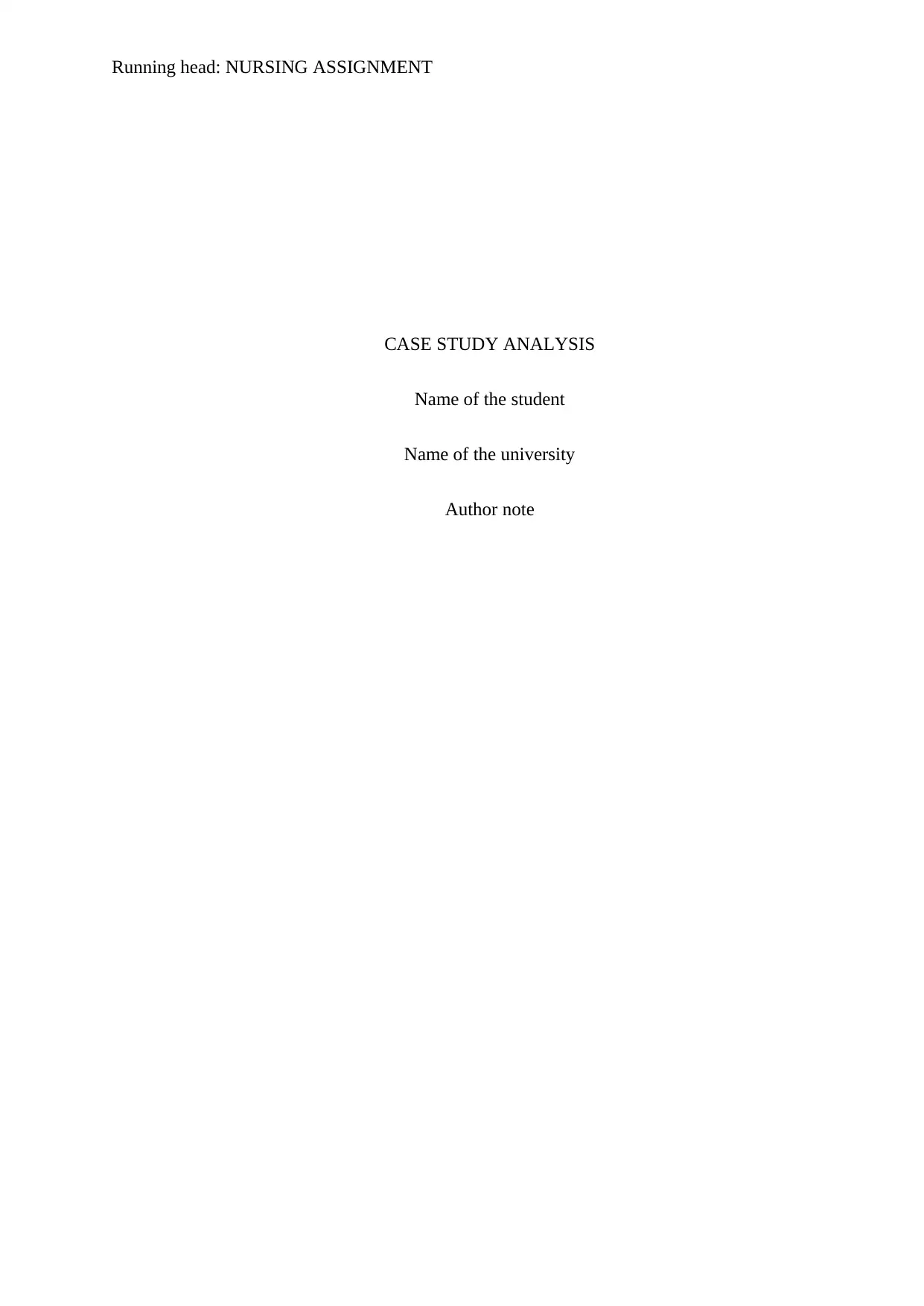
Running head: NURSING ASSIGNMENT
CASE STUDY ANALYSIS
Name of the student
Name of the university
Author note
CASE STUDY ANALYSIS
Name of the student
Name of the university
Author note
Paraphrase This Document
Need a fresh take? Get an instant paraphrase of this document with our AI Paraphraser
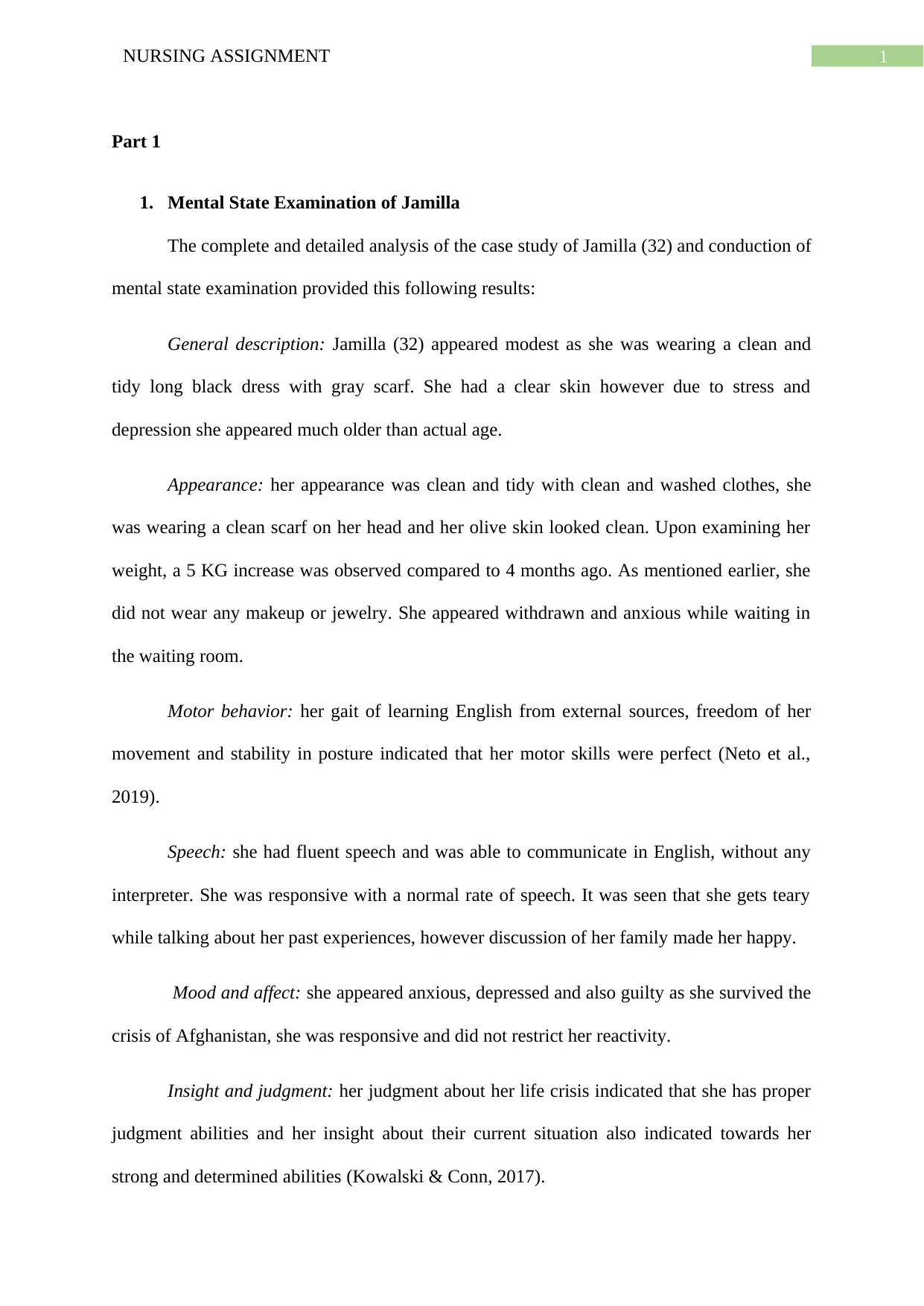
1NURSING ASSIGNMENT
Part 1
1. Mental State Examination of Jamilla
The complete and detailed analysis of the case study of Jamilla (32) and conduction of
mental state examination provided this following results:
General description: Jamilla (32) appeared modest as she was wearing a clean and
tidy long black dress with gray scarf. She had a clear skin however due to stress and
depression she appeared much older than actual age.
Appearance: her appearance was clean and tidy with clean and washed clothes, she
was wearing a clean scarf on her head and her olive skin looked clean. Upon examining her
weight, a 5 KG increase was observed compared to 4 months ago. As mentioned earlier, she
did not wear any makeup or jewelry. She appeared withdrawn and anxious while waiting in
the waiting room.
Motor behavior: her gait of learning English from external sources, freedom of her
movement and stability in posture indicated that her motor skills were perfect (Neto et al.,
2019).
Speech: she had fluent speech and was able to communicate in English, without any
interpreter. She was responsive with a normal rate of speech. It was seen that she gets teary
while talking about her past experiences, however discussion of her family made her happy.
Mood and affect: she appeared anxious, depressed and also guilty as she survived the
crisis of Afghanistan, she was responsive and did not restrict her reactivity.
Insight and judgment: her judgment about her life crisis indicated that she has proper
judgment abilities and her insight about their current situation also indicated towards her
strong and determined abilities (Kowalski & Conn, 2017).
Part 1
1. Mental State Examination of Jamilla
The complete and detailed analysis of the case study of Jamilla (32) and conduction of
mental state examination provided this following results:
General description: Jamilla (32) appeared modest as she was wearing a clean and
tidy long black dress with gray scarf. She had a clear skin however due to stress and
depression she appeared much older than actual age.
Appearance: her appearance was clean and tidy with clean and washed clothes, she
was wearing a clean scarf on her head and her olive skin looked clean. Upon examining her
weight, a 5 KG increase was observed compared to 4 months ago. As mentioned earlier, she
did not wear any makeup or jewelry. She appeared withdrawn and anxious while waiting in
the waiting room.
Motor behavior: her gait of learning English from external sources, freedom of her
movement and stability in posture indicated that her motor skills were perfect (Neto et al.,
2019).
Speech: she had fluent speech and was able to communicate in English, without any
interpreter. She was responsive with a normal rate of speech. It was seen that she gets teary
while talking about her past experiences, however discussion of her family made her happy.
Mood and affect: she appeared anxious, depressed and also guilty as she survived the
crisis of Afghanistan, she was responsive and did not restrict her reactivity.
Insight and judgment: her judgment about her life crisis indicated that she has proper
judgment abilities and her insight about their current situation also indicated towards her
strong and determined abilities (Kowalski & Conn, 2017).
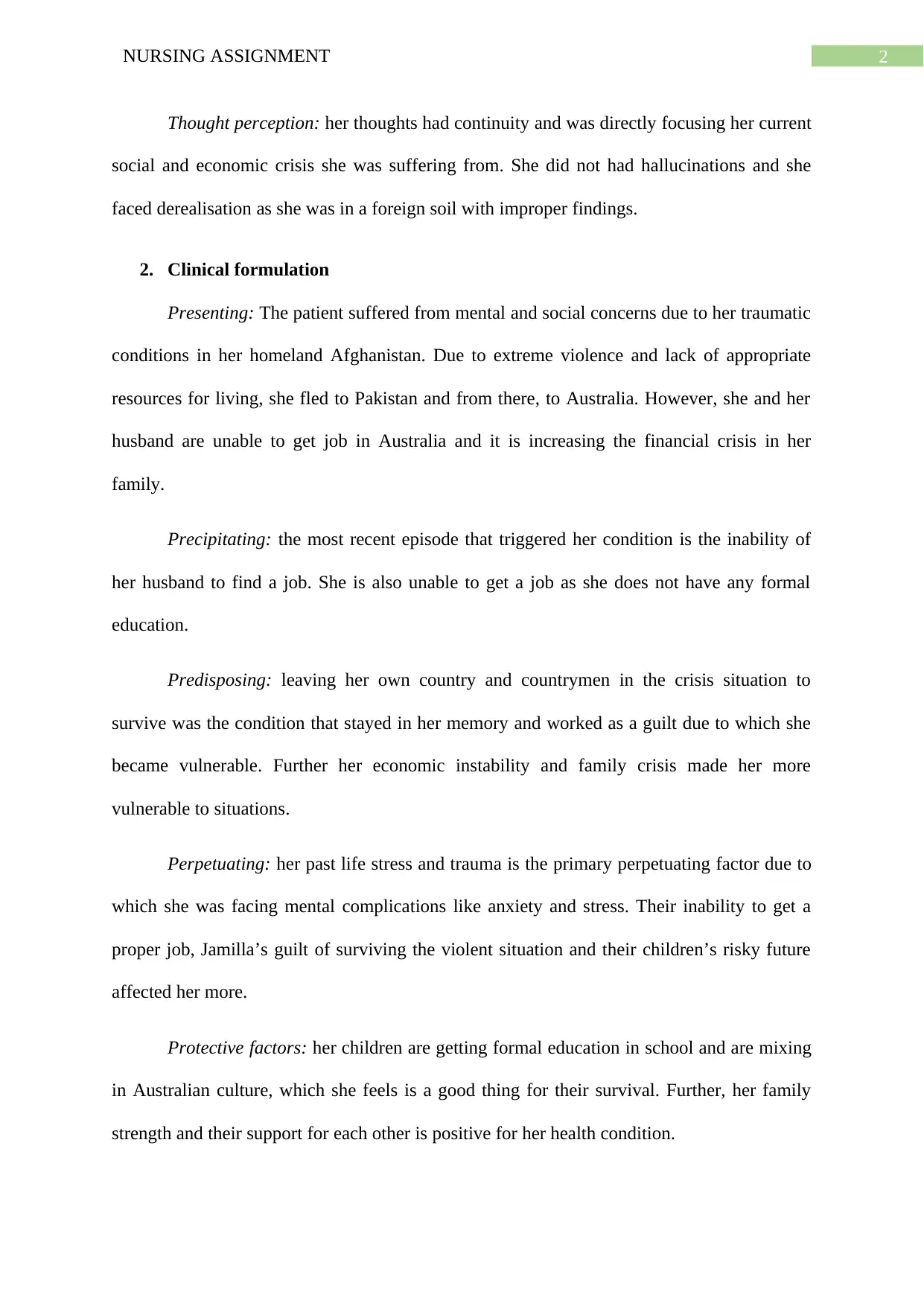
2NURSING ASSIGNMENT
Thought perception: her thoughts had continuity and was directly focusing her current
social and economic crisis she was suffering from. She did not had hallucinations and she
faced derealisation as she was in a foreign soil with improper findings.
2. Clinical formulation
Presenting: The patient suffered from mental and social concerns due to her traumatic
conditions in her homeland Afghanistan. Due to extreme violence and lack of appropriate
resources for living, she fled to Pakistan and from there, to Australia. However, she and her
husband are unable to get job in Australia and it is increasing the financial crisis in her
family.
Precipitating: the most recent episode that triggered her condition is the inability of
her husband to find a job. She is also unable to get a job as she does not have any formal
education.
Predisposing: leaving her own country and countrymen in the crisis situation to
survive was the condition that stayed in her memory and worked as a guilt due to which she
became vulnerable. Further her economic instability and family crisis made her more
vulnerable to situations.
Perpetuating: her past life stress and trauma is the primary perpetuating factor due to
which she was facing mental complications like anxiety and stress. Their inability to get a
proper job, Jamilla’s guilt of surviving the violent situation and their children’s risky future
affected her more.
Protective factors: her children are getting formal education in school and are mixing
in Australian culture, which she feels is a good thing for their survival. Further, her family
strength and their support for each other is positive for her health condition.
Thought perception: her thoughts had continuity and was directly focusing her current
social and economic crisis she was suffering from. She did not had hallucinations and she
faced derealisation as she was in a foreign soil with improper findings.
2. Clinical formulation
Presenting: The patient suffered from mental and social concerns due to her traumatic
conditions in her homeland Afghanistan. Due to extreme violence and lack of appropriate
resources for living, she fled to Pakistan and from there, to Australia. However, she and her
husband are unable to get job in Australia and it is increasing the financial crisis in her
family.
Precipitating: the most recent episode that triggered her condition is the inability of
her husband to find a job. She is also unable to get a job as she does not have any formal
education.
Predisposing: leaving her own country and countrymen in the crisis situation to
survive was the condition that stayed in her memory and worked as a guilt due to which she
became vulnerable. Further her economic instability and family crisis made her more
vulnerable to situations.
Perpetuating: her past life stress and trauma is the primary perpetuating factor due to
which she was facing mental complications like anxiety and stress. Their inability to get a
proper job, Jamilla’s guilt of surviving the violent situation and their children’s risky future
affected her more.
Protective factors: her children are getting formal education in school and are mixing
in Australian culture, which she feels is a good thing for their survival. Further, her family
strength and their support for each other is positive for her health condition.
⊘ This is a preview!⊘
Do you want full access?
Subscribe today to unlock all pages.

Trusted by 1+ million students worldwide
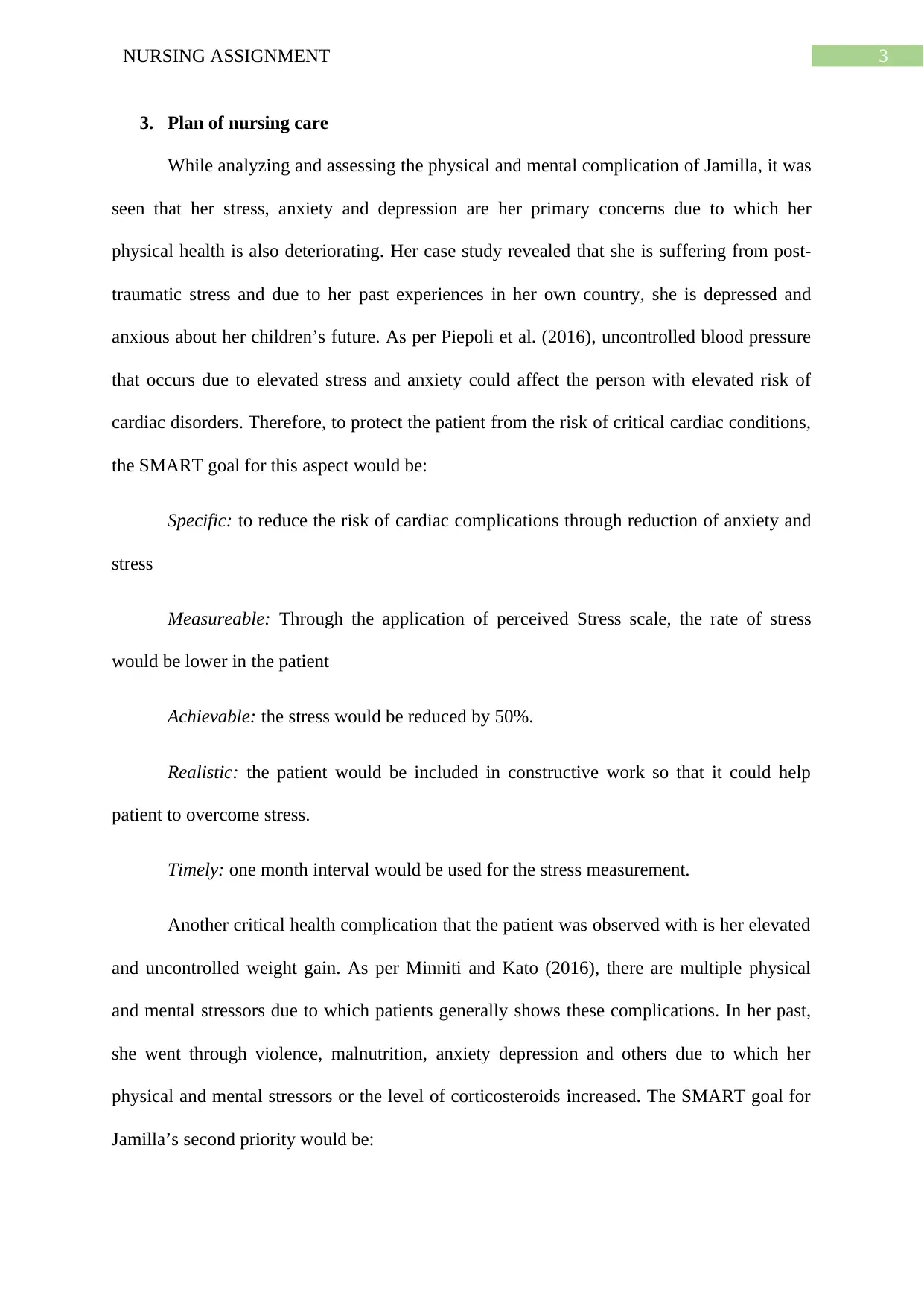
3NURSING ASSIGNMENT
3. Plan of nursing care
While analyzing and assessing the physical and mental complication of Jamilla, it was
seen that her stress, anxiety and depression are her primary concerns due to which her
physical health is also deteriorating. Her case study revealed that she is suffering from post-
traumatic stress and due to her past experiences in her own country, she is depressed and
anxious about her children’s future. As per Piepoli et al. (2016), uncontrolled blood pressure
that occurs due to elevated stress and anxiety could affect the person with elevated risk of
cardiac disorders. Therefore, to protect the patient from the risk of critical cardiac conditions,
the SMART goal for this aspect would be:
Specific: to reduce the risk of cardiac complications through reduction of anxiety and
stress
Measureable: Through the application of perceived Stress scale, the rate of stress
would be lower in the patient
Achievable: the stress would be reduced by 50%.
Realistic: the patient would be included in constructive work so that it could help
patient to overcome stress.
Timely: one month interval would be used for the stress measurement.
Another critical health complication that the patient was observed with is her elevated
and uncontrolled weight gain. As per Minniti and Kato (2016), there are multiple physical
and mental stressors due to which patients generally shows these complications. In her past,
she went through violence, malnutrition, anxiety depression and others due to which her
physical and mental stressors or the level of corticosteroids increased. The SMART goal for
Jamilla’s second priority would be:
3. Plan of nursing care
While analyzing and assessing the physical and mental complication of Jamilla, it was
seen that her stress, anxiety and depression are her primary concerns due to which her
physical health is also deteriorating. Her case study revealed that she is suffering from post-
traumatic stress and due to her past experiences in her own country, she is depressed and
anxious about her children’s future. As per Piepoli et al. (2016), uncontrolled blood pressure
that occurs due to elevated stress and anxiety could affect the person with elevated risk of
cardiac disorders. Therefore, to protect the patient from the risk of critical cardiac conditions,
the SMART goal for this aspect would be:
Specific: to reduce the risk of cardiac complications through reduction of anxiety and
stress
Measureable: Through the application of perceived Stress scale, the rate of stress
would be lower in the patient
Achievable: the stress would be reduced by 50%.
Realistic: the patient would be included in constructive work so that it could help
patient to overcome stress.
Timely: one month interval would be used for the stress measurement.
Another critical health complication that the patient was observed with is her elevated
and uncontrolled weight gain. As per Minniti and Kato (2016), there are multiple physical
and mental stressors due to which patients generally shows these complications. In her past,
she went through violence, malnutrition, anxiety depression and others due to which her
physical and mental stressors or the level of corticosteroids increased. The SMART goal for
Jamilla’s second priority would be:
Paraphrase This Document
Need a fresh take? Get an instant paraphrase of this document with our AI Paraphraser

4NURSING ASSIGNMENT
Specific: rate of weight gain would be reduced in Jamilla by analyzing her diet and
incorporating factors that could prevent her overeating due to stress.
Measureable: she would be asked to lose a certain amount of weight so that the
patient could be protected from the risk factors of diabetes. It would be measured by
analyzing the health complication of patient,
Achievable: the patient would be asked to comply with the diet and national chart
provided and would be asked to take part in physical activities so that the amount of physical;
and mental stressors could be reduced.
Realistic: as the patient is suffering from stress and depression, 50% compliance to
the provided interventions would be expected.
Timely: within one month, she would lose her 4 KG weight.
4. Clinical handover
S-Situation: the patient has been identified post- traumatic stress and presented with
anxiety and depression in community care clinic. Her past experience related to violence and
lack of food in Afghanistan affected her health condition.
B-Background: Jamilla, her husband and their two children fled from Afghanistan
after the violence related episodes. They now own a permanent residence in Australia
however social loneliness and isolation prevails in Australian community for this family.
A-Assessment: vital sign assessment showed that the patient has optimum level of
body temperature, heart rate, respiratory rate, however her elevated blood pressure, and
increased body weight increased her health complications.
Specific: rate of weight gain would be reduced in Jamilla by analyzing her diet and
incorporating factors that could prevent her overeating due to stress.
Measureable: she would be asked to lose a certain amount of weight so that the
patient could be protected from the risk factors of diabetes. It would be measured by
analyzing the health complication of patient,
Achievable: the patient would be asked to comply with the diet and national chart
provided and would be asked to take part in physical activities so that the amount of physical;
and mental stressors could be reduced.
Realistic: as the patient is suffering from stress and depression, 50% compliance to
the provided interventions would be expected.
Timely: within one month, she would lose her 4 KG weight.
4. Clinical handover
S-Situation: the patient has been identified post- traumatic stress and presented with
anxiety and depression in community care clinic. Her past experience related to violence and
lack of food in Afghanistan affected her health condition.
B-Background: Jamilla, her husband and their two children fled from Afghanistan
after the violence related episodes. They now own a permanent residence in Australia
however social loneliness and isolation prevails in Australian community for this family.
A-Assessment: vital sign assessment showed that the patient has optimum level of
body temperature, heart rate, respiratory rate, however her elevated blood pressure, and
increased body weight increased her health complications.

5NURSING ASSIGNMENT
R-Recommendations: the patient should be provided with effective care and
specifically for elevated blood pressure and body weight as it could increase her chances of
cardiac complications and lifestyle complications respectively.
Part 2
5. Therapeutic relationship
As per Burnham (2018) therapeutic relationship is the rapport that has been developed
by the nursing professional with the patient so that with development of trust, mutual respect,
hope and faith, they could help the patient to develop improved physical. Mental and
emotional health. In this situation, it was seen that Jamilla is lonely and feels isolated without
any family and friend in Australia. She is unable to trust people and hence she is unable to
share her mental complications to others. As per Lawn et al. (2019), communication and
sense of familiarity works as stressors due to which they suffer from mental and physical
complications. As per Nicolaides et al. (2015), due to increased environmental stressors, the
level of corticosteroids increases in the human body, leading to several complications that
affects the physiological processes of the body. Similar complication might be witnessed in
the health complication of the patient and her increased blood pressure, elevated body weight
indicates towards similar condition. Hence, appropriate and timely application of intervention
and communication process becomes important for Jamilla so that the level of environmental
and physical stressors could be reduced (Albert, 2016).
Application of this therapeutic relationship in the form of counselling of effective
communication would help the Jamilla to convey her both, positive and negative thoughts to
the healthcare facilities effectively and they would be able to understand the primary or
perpetuating factors that are triggering such complicated conditions in the patients. Through
the developed effective communication, the patient would be informed and educated about
R-Recommendations: the patient should be provided with effective care and
specifically for elevated blood pressure and body weight as it could increase her chances of
cardiac complications and lifestyle complications respectively.
Part 2
5. Therapeutic relationship
As per Burnham (2018) therapeutic relationship is the rapport that has been developed
by the nursing professional with the patient so that with development of trust, mutual respect,
hope and faith, they could help the patient to develop improved physical. Mental and
emotional health. In this situation, it was seen that Jamilla is lonely and feels isolated without
any family and friend in Australia. She is unable to trust people and hence she is unable to
share her mental complications to others. As per Lawn et al. (2019), communication and
sense of familiarity works as stressors due to which they suffer from mental and physical
complications. As per Nicolaides et al. (2015), due to increased environmental stressors, the
level of corticosteroids increases in the human body, leading to several complications that
affects the physiological processes of the body. Similar complication might be witnessed in
the health complication of the patient and her increased blood pressure, elevated body weight
indicates towards similar condition. Hence, appropriate and timely application of intervention
and communication process becomes important for Jamilla so that the level of environmental
and physical stressors could be reduced (Albert, 2016).
Application of this therapeutic relationship in the form of counselling of effective
communication would help the Jamilla to convey her both, positive and negative thoughts to
the healthcare facilities effectively and they would be able to understand the primary or
perpetuating factors that are triggering such complicated conditions in the patients. Through
the developed effective communication, the patient would be informed and educated about
⊘ This is a preview!⊘
Do you want full access?
Subscribe today to unlock all pages.

Trusted by 1+ million students worldwide

6NURSING ASSIGNMENT
her risk of developing cardiac complications and she would also be informed about the
reasons of developing such complications. Further, as per Lawn et al. (2019), it was seen that
with effective communication, nursing professionals would be able to comfort the isolation
and loneliness related feelings of the patients and hence, it should be applied in the care
process of Jamilla.
6. Connection of nursing interventions with principles of recovery model
As per Fenton et al. (2017), the principles of recovery model are attributes that defines
the mental or physical health complication of the patient and determines that these people
should be provided with effective care and intervention so that they could recover from
critical conditions. These recovery oriented principles are uniqueness of every individual,
their rights and attitudes, maintaining the respect and dignity of the patient, developing
communication partnership with the patients. The two priority based interventions that has
been implemented for the patient, maintains the dignity, rights and uniqueness of the patient
(Best et al., 2016). Further, with effective communication, the nursing professional would be
able to develop a rapport that would help them to educate the patient about her increasing
environmental and physical stressors. Hence. While working with this patient, I would be
using these recovery based approach for the growth and development of the improved patient
condition (Banyard, Hamby & Grych, 2017). As per Gould (2016), these are the aspects of
the recovery oriented mental healthcare process that would help the patient to understand the
patient about her critical health complication and it would help them to overcome their
critical health complication, with the help of the nursing professionals.
However, while providing the patient with these effective and above-mentioned
interventions, there are several complications that might arise and could affect the health
condition of the patient. It was mentioned in the case study that patient is feeling guilty about
leaving her homeland and her countrymen dying as well as about her survival. Further, it was
her risk of developing cardiac complications and she would also be informed about the
reasons of developing such complications. Further, as per Lawn et al. (2019), it was seen that
with effective communication, nursing professionals would be able to comfort the isolation
and loneliness related feelings of the patients and hence, it should be applied in the care
process of Jamilla.
6. Connection of nursing interventions with principles of recovery model
As per Fenton et al. (2017), the principles of recovery model are attributes that defines
the mental or physical health complication of the patient and determines that these people
should be provided with effective care and intervention so that they could recover from
critical conditions. These recovery oriented principles are uniqueness of every individual,
their rights and attitudes, maintaining the respect and dignity of the patient, developing
communication partnership with the patients. The two priority based interventions that has
been implemented for the patient, maintains the dignity, rights and uniqueness of the patient
(Best et al., 2016). Further, with effective communication, the nursing professional would be
able to develop a rapport that would help them to educate the patient about her increasing
environmental and physical stressors. Hence. While working with this patient, I would be
using these recovery based approach for the growth and development of the improved patient
condition (Banyard, Hamby & Grych, 2017). As per Gould (2016), these are the aspects of
the recovery oriented mental healthcare process that would help the patient to understand the
patient about her critical health complication and it would help them to overcome their
critical health complication, with the help of the nursing professionals.
However, while providing the patient with these effective and above-mentioned
interventions, there are several complications that might arise and could affect the health
condition of the patient. It was mentioned in the case study that patient is feeling guilty about
leaving her homeland and her countrymen dying as well as about her survival. Further, it was
Paraphrase This Document
Need a fresh take? Get an instant paraphrase of this document with our AI Paraphraser

7NURSING ASSIGNMENT
mentioned that she was feeling lonely and hence, through the application of this therapeutic
intervention I would be able to make personal connection with the patient so that she could
overcome her mental complication and focus upon the interventions (Best et al., 2016).
Further, with the application of the therapeutic communication it would be effective to
increase the patient’s understanding about her health condition and she would be able to her
health complications (Banyard, Hamby & Grych, 2017). Hence, these are the aspects that
would be applied with therapeutic relationship with Jamilla to make her health condition
improved.
mentioned that she was feeling lonely and hence, through the application of this therapeutic
intervention I would be able to make personal connection with the patient so that she could
overcome her mental complication and focus upon the interventions (Best et al., 2016).
Further, with the application of the therapeutic communication it would be effective to
increase the patient’s understanding about her health condition and she would be able to her
health complications (Banyard, Hamby & Grych, 2017). Hence, these are the aspects that
would be applied with therapeutic relationship with Jamilla to make her health condition
improved.
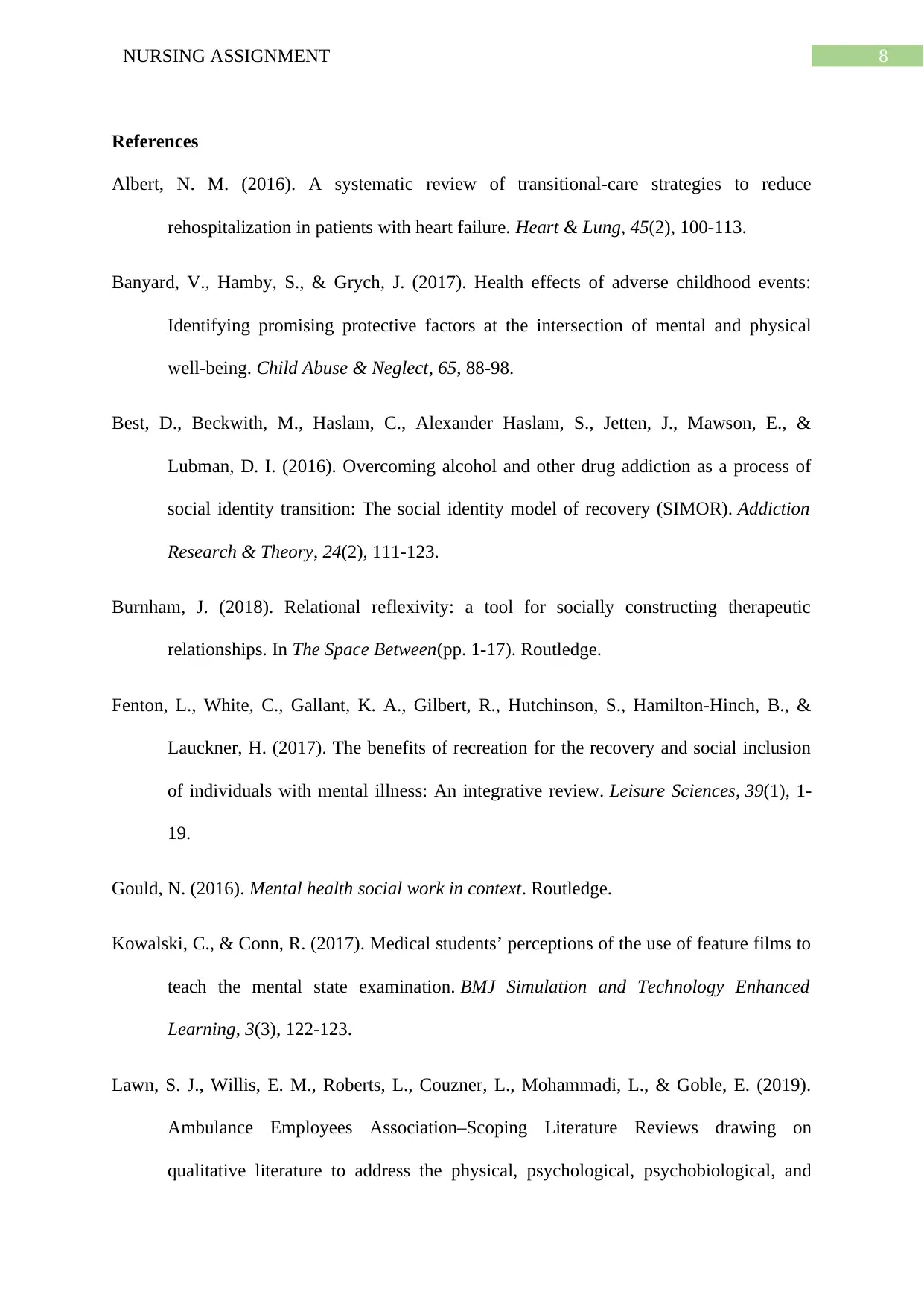
8NURSING ASSIGNMENT
References
Albert, N. M. (2016). A systematic review of transitional-care strategies to reduce
rehospitalization in patients with heart failure. Heart & Lung, 45(2), 100-113.
Banyard, V., Hamby, S., & Grych, J. (2017). Health effects of adverse childhood events:
Identifying promising protective factors at the intersection of mental and physical
well-being. Child Abuse & Neglect, 65, 88-98.
Best, D., Beckwith, M., Haslam, C., Alexander Haslam, S., Jetten, J., Mawson, E., &
Lubman, D. I. (2016). Overcoming alcohol and other drug addiction as a process of
social identity transition: The social identity model of recovery (SIMOR). Addiction
Research & Theory, 24(2), 111-123.
Burnham, J. (2018). Relational reflexivity: a tool for socially constructing therapeutic
relationships. In The Space Between(pp. 1-17). Routledge.
Fenton, L., White, C., Gallant, K. A., Gilbert, R., Hutchinson, S., Hamilton-Hinch, B., &
Lauckner, H. (2017). The benefits of recreation for the recovery and social inclusion
of individuals with mental illness: An integrative review. Leisure Sciences, 39(1), 1-
19.
Gould, N. (2016). Mental health social work in context. Routledge.
Kowalski, C., & Conn, R. (2017). Medical students’ perceptions of the use of feature films to
teach the mental state examination. BMJ Simulation and Technology Enhanced
Learning, 3(3), 122-123.
Lawn, S. J., Willis, E. M., Roberts, L., Couzner, L., Mohammadi, L., & Goble, E. (2019).
Ambulance Employees Association–Scoping Literature Reviews drawing on
qualitative literature to address the physical, psychological, psychobiological, and
References
Albert, N. M. (2016). A systematic review of transitional-care strategies to reduce
rehospitalization in patients with heart failure. Heart & Lung, 45(2), 100-113.
Banyard, V., Hamby, S., & Grych, J. (2017). Health effects of adverse childhood events:
Identifying promising protective factors at the intersection of mental and physical
well-being. Child Abuse & Neglect, 65, 88-98.
Best, D., Beckwith, M., Haslam, C., Alexander Haslam, S., Jetten, J., Mawson, E., &
Lubman, D. I. (2016). Overcoming alcohol and other drug addiction as a process of
social identity transition: The social identity model of recovery (SIMOR). Addiction
Research & Theory, 24(2), 111-123.
Burnham, J. (2018). Relational reflexivity: a tool for socially constructing therapeutic
relationships. In The Space Between(pp. 1-17). Routledge.
Fenton, L., White, C., Gallant, K. A., Gilbert, R., Hutchinson, S., Hamilton-Hinch, B., &
Lauckner, H. (2017). The benefits of recreation for the recovery and social inclusion
of individuals with mental illness: An integrative review. Leisure Sciences, 39(1), 1-
19.
Gould, N. (2016). Mental health social work in context. Routledge.
Kowalski, C., & Conn, R. (2017). Medical students’ perceptions of the use of feature films to
teach the mental state examination. BMJ Simulation and Technology Enhanced
Learning, 3(3), 122-123.
Lawn, S. J., Willis, E. M., Roberts, L., Couzner, L., Mohammadi, L., & Goble, E. (2019).
Ambulance Employees Association–Scoping Literature Reviews drawing on
qualitative literature to address the physical, psychological, psychobiological, and
⊘ This is a preview!⊘
Do you want full access?
Subscribe today to unlock all pages.

Trusted by 1+ million students worldwide
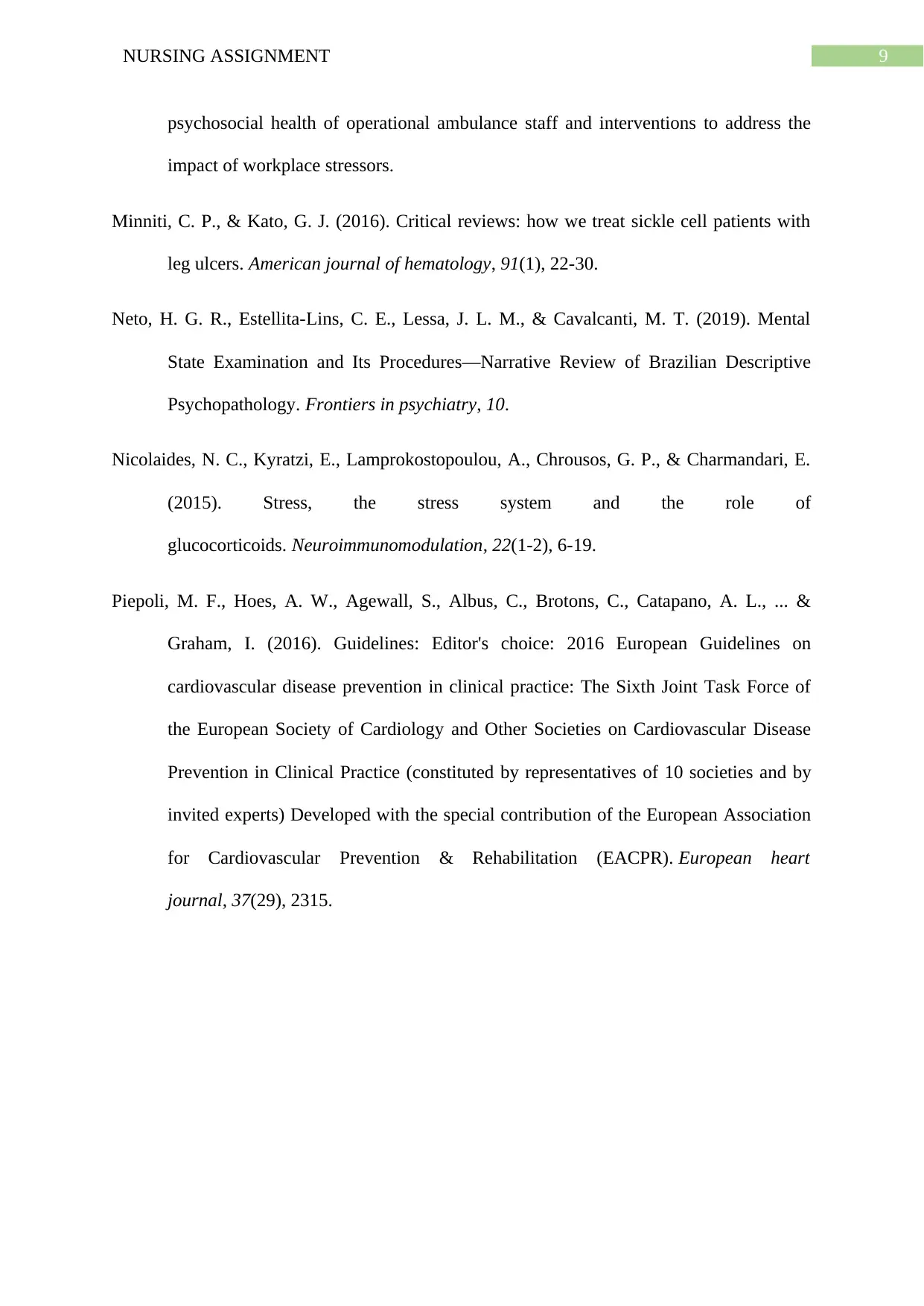
9NURSING ASSIGNMENT
psychosocial health of operational ambulance staff and interventions to address the
impact of workplace stressors.
Minniti, C. P., & Kato, G. J. (2016). Critical reviews: how we treat sickle cell patients with
leg ulcers. American journal of hematology, 91(1), 22-30.
Neto, H. G. R., Estellita-Lins, C. E., Lessa, J. L. M., & Cavalcanti, M. T. (2019). Mental
State Examination and Its Procedures—Narrative Review of Brazilian Descriptive
Psychopathology. Frontiers in psychiatry, 10.
Nicolaides, N. C., Kyratzi, E., Lamprokostopoulou, A., Chrousos, G. P., & Charmandari, E.
(2015). Stress, the stress system and the role of
glucocorticoids. Neuroimmunomodulation, 22(1-2), 6-19.
Piepoli, M. F., Hoes, A. W., Agewall, S., Albus, C., Brotons, C., Catapano, A. L., ... &
Graham, I. (2016). Guidelines: Editor's choice: 2016 European Guidelines on
cardiovascular disease prevention in clinical practice: The Sixth Joint Task Force of
the European Society of Cardiology and Other Societies on Cardiovascular Disease
Prevention in Clinical Practice (constituted by representatives of 10 societies and by
invited experts) Developed with the special contribution of the European Association
for Cardiovascular Prevention & Rehabilitation (EACPR). European heart
journal, 37(29), 2315.
psychosocial health of operational ambulance staff and interventions to address the
impact of workplace stressors.
Minniti, C. P., & Kato, G. J. (2016). Critical reviews: how we treat sickle cell patients with
leg ulcers. American journal of hematology, 91(1), 22-30.
Neto, H. G. R., Estellita-Lins, C. E., Lessa, J. L. M., & Cavalcanti, M. T. (2019). Mental
State Examination and Its Procedures—Narrative Review of Brazilian Descriptive
Psychopathology. Frontiers in psychiatry, 10.
Nicolaides, N. C., Kyratzi, E., Lamprokostopoulou, A., Chrousos, G. P., & Charmandari, E.
(2015). Stress, the stress system and the role of
glucocorticoids. Neuroimmunomodulation, 22(1-2), 6-19.
Piepoli, M. F., Hoes, A. W., Agewall, S., Albus, C., Brotons, C., Catapano, A. L., ... &
Graham, I. (2016). Guidelines: Editor's choice: 2016 European Guidelines on
cardiovascular disease prevention in clinical practice: The Sixth Joint Task Force of
the European Society of Cardiology and Other Societies on Cardiovascular Disease
Prevention in Clinical Practice (constituted by representatives of 10 societies and by
invited experts) Developed with the special contribution of the European Association
for Cardiovascular Prevention & Rehabilitation (EACPR). European heart
journal, 37(29), 2315.
1 out of 10
Related Documents
Your All-in-One AI-Powered Toolkit for Academic Success.
+13062052269
info@desklib.com
Available 24*7 on WhatsApp / Email
![[object Object]](/_next/static/media/star-bottom.7253800d.svg)
Unlock your academic potential
Copyright © 2020–2025 A2Z Services. All Rights Reserved. Developed and managed by ZUCOL.





